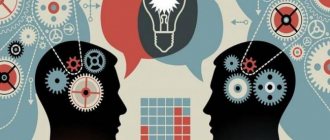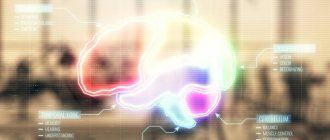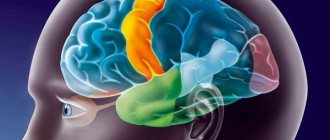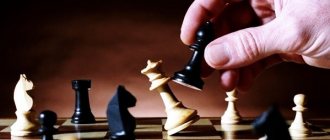The article presents a detailed description of the types of human thinking. Classification, features, violations.
Thinking as the highest form of cognitive activity allows a person to logically connect ongoing events and phenomena, as well as generalize the results of personal sensory experience and reflect the general properties of objects. Based on generalizations, we then solve specific cognitive problems. Thinking helps us give answers to questions that cannot be resolved through sensory reflection alone. It helps us navigate the world around us and apply the generalizations and experiences we have previously gained in an ever-changing environment.
What is thinking
Thinking is a cognitive process that allows a person to perceive, realize reality and express this in his own activities. It endows surrounding objects with properties and relationships with each other. Thanks to mental activity, each person’s picture of the world is formed.
There are the following main signs of thinking:
- Mediation – cognitive activity is based on data from the senses and does not interact directly with reality;
- Generalization is the ability to find common properties in objects of the same type.
These characteristics are inherent in every person. In mental illness, a disorder in the basic features of thought processes may occur - for example, the search for similarities in dissimilar objects.
Right-brain and left-brain thinking
Each hemisphere is characterized by the predominance of certain processes. Based on this feature, the main types of thinking were identified:
- Left hemisphere - the process is dominated by analytical and synthetic processes, logical constructions;
- Right-hemisphere - relies on images and intuition;
- Mixed is the alternate work of each hemisphere;
- Integrated – simultaneous work of both hemispheres.
It is wrong to say that one type of mental activity is preferable to another. Each of them is capable of coming to both correct and incorrect conclusions. Left-hemisphere thinking gives leadership qualities, right-hemisphere thinking gives a strong emotional response. Mixed, thanks to its ability to “switch,” can use the strengths of both hemispheres. But this process does not always happen on time. The same goes for the integrated type.
Development of different types of thinking
Types of communication in psychology - what they include, its functions
For full independent development, you can improve it without even understanding what thinking is like. To do this, you need to track cause-and-effect relationships in everything, try to investigate every situation that deserves attention.
Interesting. Compare similar situations. For example, plants bloom on one windowsill, but the same ones on another do not. It is important to compare: whether watering occurs at the same time, what is the illumination of the room, are there any drafts, what is the pot made of, is the composition of the soil the same.
Ask yourself questions as much as possible, like younger children. Many things for adults are obvious, invisible, and not worthy of attention. But when a child who is able to speak appears in the house, he asks his parents a lot of questions, a considerable percentage of which often confuse adults. Children see everything differently, their brain is not limited by generally accepted principles, they are able to think broadly and very creatively. It is important for all adults to learn to think like children, not to limit themselves to customs, habits and experience.
The type of creative thinking, on the one hand, is the simplest - the main thing is to use imagination. On the other hand, it is one of the most complex and difficult to learn. If creativity is not the strongest side of your personality, you can use a ready-made list of tasks for development. Examples of thinking training:
- Imagine what the most ordinary green tree looks like if it is turned inside out.
- List the ways to use a round stone with a diameter of 15 cm (name at least 15 uses).
- List everything that is white in nature (or any other natural shade). Typically, the first things that come to mind are clouds, snow and a polar bear. Only in the fifth minute of reasoning will the subject name egg white, salt and sugar, and sea foam and limestone can be expected only after the twentieth minute of exercise.
- Before going to bed, spend 30 minutes on various tests. Over time, thanks to training, the results will improve. IQ tests should not be ignored. The first characteristic you receive should not upset you; its task is to become a motive for starting to work on yourself.
IQ test
- Read specific literature that was not previously attractive; the list should include works of fiction that will help teach you to dream.
- Even in social studies classes, schoolchildren are asked to write a paper on the topic “if I were...” and name their profession. It is also useful for an adult to use this technique once or twice a week, thinking about what kind of specialist he could become, the manifestation of what personal qualities could be observed under the circumstances that arise.
The human essence is prone to laziness, therefore the brain of one who is subject to daily life difficulties is more developed, in contrast to those whose life flows measuredly, without requiring strength of character and cunning. A striking example is the comparison of a villager and a city dweller. The first one knows how his own sewer system works and is able to independently and quickly determine the cause of the malfunction using deduction, analysis, and critical thinking. The city dweller, based on reflexive thinking, will turn off the water, plug the drain hole and call a specialist, without going into details.
Table of classification of thinking in psychology
| Classification criterion | Type of thinking | Application area |
| By functional difference | Creative | art, advertising, PR activities |
| Critical | medicine, military service, transport | |
| By novelty | Reproductive | pedagogy, construction |
| Productive | design, modeling, engineering | |
| By type of problem solved | Practical | logistics areas |
| Theoretical | philosophy, analysis, secondary education | |
| By degree of deployment | Analytical | military-strategic direction, accounting, audit |
| Intuitive | in everyday life, when meeting something new |
The use of one or another type of thinking is not limited to the given areas of application; this is just a short list to which each type belongs. It is often difficult to identify any one type of thought process. Very often they are used in combination, complementing each other and expanding capabilities.
Reading
The daily learning process, independently used for one’s brain activity, is capable of developing the typology of thinking to the fullest. People with strong willpower can train their minds on their own, because this process is not easy. If you do this regularly, you can achieve a lot in life, and also greatly reduce the risk of developing sclerosis and dementia in old age.
Classification
In psychology, types of thinking are distinguished depending on the way a person comes to conclusions:
- Visual-effective - cognitive activity based on the perception of specific objects and manipulations with them;
- Visual-figurative – relies on images and judgments, allows the use of specific images to illustrate conclusions;
- Verbal-logical – based on logical constructions and inferences. Able to reason about abstract concepts;
- Subject-effective – close to visual-effective. Used to solve applied problems;
- Empirical - using lived experience to make inferences.
Each person has all types to one degree or another. The verbal-logical or abstract type develops later than the others. Characteristic only for humans. Other types appear to varying degrees in some animals. In essence, abstract thinking allows a person to use a wide conceptual apparatus and transfer knowledge through indirect sources - a book, an educational film, etc.
Why is it important to develop out-of-the-box thinking?
Each newborn person can be called unique. Even during the Middle Ages, when all people were divided into classes that determined their way of life, it was possible to identify special people who thought differently from the rest. In our time, the visual-figurative type of thinking is an unusual state of a person’s inner world, his soul, and modern society needs such people. Today, the ability to see the world differently is not limited to painting or literary talent. People with this type of thinking have managed to find a place for themselves in information technologies, which, in turn, cover almost all spheres of human life.
Visually effective type
This is the earliest form of mental activity that develops in humans. It is typical for children under 3 years of age. Mental operations are based on manipulations with really existing tangible objects. Each problem is solved immediately at the practical stage, during manipulations with objects. Thinking disorders of this type are rare. Mainly with severe mental retardation. They lead to the fact that the process of development of brain activity as a whole slows down or stops.
How and when does developmental disorder develop?
This is the first stage in the development of mental activity. The time frame for its development to begin varies. Some experts indicate that a child is capable of simple mental operations from birth. Others say that the development of mental processes is closely related to the ability to move and appears simultaneously with a decrease in muscle hypertonicity. Estimated time frame: 6 months – 1 year.
Vivid and uncontrolled manifestations of visual-effective thinking in children over 3 years of age, adolescents and adults indicate serious mental disorders - mental retardation, regression in psychosis. The patient exhibits a pronounced desire to grab, break and hide surrounding objects.
Manual or visual-effective thinking of children and ways of its development
This type of solving life problems got its name due to the fact that the child constantly performs some kind of manipulation with surrounding objects. The most striking manifestations are the baby grabbing toys, knocking them, testing them, licking them, trying to take them apart and put them back together.
It makes no sense to wean a child from these manipulations; a much more important task for parents is to provide the child with toys that he can disassemble and assemble without damaging them. An excellent option is sorters. This educational toy has many functions and modifications. The principle of operation is usually similar - assemble, disassemble, correlate colors, edges, shapes. This is both a puzzle and a construction set in one toy. Check out the selection of smart toys in different prices and variations.
Visually effective type of thinking in adults
In adults, such mental operations are involved in cases where the result of actions cannot be predicted on the basis of existing inferences. A striking example is mastering an unfamiliar technique. Arrangement of furniture in the room or objects on the table, selection of necessary materials according to shape, texture, subjective sensations.
What are the disadvantages
Psychologists also warn about the dangers of figurative thinking.
The problem is that it can lead too far from reality, especially if it prevails over the action-figurative and verbal-logical. Children, captivated by their own images in their heads, begin not only to compose fables, but also to believe in them. And, if in children this imbalance is easily corrected with the help of psychotherapy, then with adults the situation is much more serious.
Firstly, many creative genius people, whose imaginative thinking is at a high peak of development, lose touch with reality and begin to imagine themselves as something like a deity. It seems to them that they are illuminated by light from above if they are allowed to see in ordinary things what others do not notice. The ego is inflated to incredible proportions, which leads to social maladjustment and various personality disorders.
Secondly, the most ordinary people, under the influence of images in their heads, begin to connect those objects and phenomena of the surrounding world that have nothing in common. This explains the belief in magic, witchcraft, and otherworldly realities. Hearing a rustling sound in the room at night, they imagine a real monster in every detail and deny the presence of mice in the house. If on the morning of Friday the 13th a salt shaker overturns and a black cat crosses the road, such suspicious people will begin to panic. And all because in their minds they will draw terrible pictures of the consequences to which all these superstitions will lead.
Another disadvantage is that there are not always enough words and figures of speech to describe the picture that takes shape in your head. Because of this, contradictions and misunderstandings often arise in everyday life. For example, a couple came to the store to choose textiles for the bedroom. One thinks that this color scheme will fit perfectly into the interior, while the other thinks that it will look too provocative and flashy. And all because they have different ideas about the same room. As scientists have proven, women see everything in brighter colors and, accordingly, choose the same things. Men are exactly the opposite.
Visual-figurative type
This form of thinking manifests itself in the fact that the child is able to imagine the final result of his actions. With the visually effective method, the baby has no idea about the result of his actions, but remembers the relationships as a result of repetition. With visual-figurative learning, the preschooler guesses what the result will be.
How and when it develops, what developmental disorders exist
Visual-figurative thinking is formed on the basis of visual-effective thinking. Formation begins at the age of about 3 years. This is the main type of mental activity of preschoolers. Reaches a peak at 5-6 years.
Signs that the baby has the beginnings of imaginative thinking:
- he is able to recognize objects without touching them,
- is able to select several similar objects,
- break simple tasks into several interconnected components.
Tools for developing an imaginative way of thinking - prefabricated toys (pyramids, cubes, puzzles -), then - observing nature, retelling what you heard, drawing from memory. The criterion that imaginative thinking is actively developing is that the baby can describe his actions before starting them.
Visual-figurative thinking disorders in childhood are a lack of skills characteristic of this stage, loss of interest in complex toys. In adults, such disorders look like this:
- Aimless manipulation of objects. Example – a patient may strike a lighter for a long time and aimlessly;
- Ridiculous actions with objects that create the feeling of a child's game;
- Imitative actions;
- Mimo actions - similar to correct ones, but deliberately ineffective (lighting a match with the other end);
- Destructive actions - aggressive or auto-aggressive.
This behavior is typical for patients with psychosis, catatonic disorders, and schizophrenia.
How do images help in mental activity?
An image is a holistic idea of the result of one’s activities. It becomes the basis for the formation of more complex abstract thinking and supports the ability to perceive holistically. In adults, the main function of images is setting goals for their actions, emotional involvement in activities, and the formation of a creative approach.
Important
Imaginative thinking can only work with those phenomena that it has already encountered, so observation is extremely important at this stage of development. Emotions are always included in the perception of an image - this is important for both children and adults engaged in creative work. At the same time, this type of brain work is not characterized by special attention to detail - it notices the important and essential qualities of an object, while the rest can be distorted or discarded.
Formation of a visual perception of the world
Concrete-figurative thinking has its own specificity. Being a higher level of brain function, it does not particularly need words. Through feelings and images, you can even express some abstract concepts, such as, for example, resentment and love, hatred and loyalty.
As mentioned earlier, the formation of concrete visual thinking in a child begins at about three years of age. The peak of its development is considered to be the period from 5 to 7 years. It is no coincidence that children at this age are often called artists and dreamers. This is the time when they have already mastered speech well. However, children’s words do not at all interfere with the images they create. They only clarify and supplement them.
The language of images is considered more difficult than speech. Much more imaginary objects can be created. At the same time, they are, as a rule, very diverse and have a wide range of sensual shades. That is why it is hardly possible to select the words available in a person’s arsenal to designate images.
Concrete-imaginative thinking is the basis of creativity, which is considered the basis of the higher process of cognition. It is not only musicians, poets and artists who have it. Concrete-imaginative thinking is characteristic of those people who have a high level of creativity and constantly invent something new. But for most people it fades into the background. In this case, primacy shifts to an abstract-logical perception of the world.
Abstract boolean type
Abstract thinking operates not only with images, but also with abstract concepts. A person who has developed this type of mental activity is able to systematize information and purposefully search for it, and plan his activities. It is considered the highest degree of development of brain activity, characteristic only of humans.
How and when it develops, possible developmental disorders
The formation of abstract thinking begins at 5-7 years of age. Late preschool and early school period. The full ability to operate with abstract concepts is formed in adolescents and remains throughout life.
Signs that a preschooler has begun to develop logical thinking:
- meaningful use of abstract concepts in speech,
- the emergence of the skill of detailed planning of one’s activities,
- understanding cause-and-effect relationships in the actions of others.
All these operations occur without direct contact with objects.
Impaired brain activity manifests itself in the inability to generalize, highlight the main thing, and understand the figurative meaning of words and expressions. To identify such disorders, tests are used in which you need to interpret a proverb or saying and identify fundamental similarities between different objects.
Peculiarities
This type of thinking uses complex logical operations. In adolescents and adults it is the main one. Thanks to it, a person is able to plan, set goals and evaluate their feasibility, evaluate his own actions and the actions of others, draw conclusions and learn from his own and others’ experiences. Characterized by deep attention to detail, understanding of context, low emotional involvement.
Properties and functions of thinking
Age-related crises in psychology - characteristics when they appear
All types of thinking perform four main functions:
- understanding;
- problem solving;
- generating your own goals:
- reflection.
The comprehension function ensures the assimilation of new information. It gives you the opportunity to repeat what you heard, paraphrasing the sentences in your own way. With the help of a concept, data is easier to remember, it is easier to recall it by applying logic to the meager input data. For example, when an inexperienced driver comes to a car service center and, out of ignorance, tells in layman’s language what he doesn’t like about the car’s operation, and the car service center employees, having an understanding of the mechanisms, laws of physics, and the sequence of operation of components, can identify the cause, relying on logic, while having meager owner details.
The problem-solving function is based on building connections between events, predicting phenomena, and choosing between available options. People use this function continuously, every day; many have already reached almost automaticity and acquired the function of reflection. When the solution to a specific problem once satisfied an individual, the next time he will use the adopted solution to solve the same problem, relying on experience; if this task is repeated regularly, thinking reflexively produces a finished result, without questioning the chosen path.
Generating your own goals is the most important function in personality development and self-improvement. By setting goals for oneself, a person is able to develop, learn new things, master skills, and expand his area of thinking. This is another distinctive feature of humans that is not inherent in animals. Representatives of the animal world solve problems that arise before them in connection with changes in weather conditions, the availability of food, and mating games. Without the influence of external factors, animals will not learn anything. For this reason, individuals raised in captivity have little chance of survival in the wild - they were raised in conditions that provided them with food by the hour, without any effort. In the wild, it is difficult for an animal to change its behavior in a short time, while at the same time learning to deal with natural competition. A person is able to develop his skills and train his skills not when it is vitally important to him, but when it may be useful in the future.
Girl learning to drive
Specific subject type
A selection of construction kits that perfectly develop subject-specific thinking
Like visual-effective thinking, the concrete-object type is associated with direct interaction with objects, but is its more developed type. A person with concrete-subject thinking, unlike a small child, has a goal and imagines the result of his actions. This type of mental activity accompanies applied operations, most often in the technical field. It allows you to “adjust” certain devices to a specific situation.
How and when does developmental disorder develop?
Practical thinking begins to develop around 4-7 years, the start time is quite flexible. What is needed is a developed visual-figurative method and the presence of at least the rudiments of the abstract-logical. This type of mental activity is formed on the basis of constant work with hands, requiring a creative approach. He is well developed by construction sets and other complex toys - a good selection.
Developmental disorders manifest themselves in the form of an inability to follow instructions, difficulty in moving from theory to practice.
Specification
When abstracting, a person is mentally distracted from certain aspects and features of the object. This allows him to gain a deeper understanding of the essence of phenomena and things. Concrete thinking is the exact opposite of abstract thinking. It returns thought from the general to reveal its content.
It is worth noting that any human reasoning always has the goal of obtaining some result. A person compares and analyzes objects using concrete thinking. He also abstracts some of their properties, with the help of which he reveals in them those patterns that govern the object of study.
Forms (criteria) of thinking
Thinking operates with several basic categories, which are characteristic mainly of the abstract-logical type.
- A concept is the simplest act of mental activity. It reflects the very fact of understanding objects or phenomena. The external manifestation of the concept is the ability to name an object using its main features (black cat, cold rain, bad mood, etc.).
- Judgment is the ability to establish relationships between concepts and combine them into groups. External expression is the ability to describe one concept using others in a sentence. Examples of judgments: a cat and a dog are animals; rain is precipitation in the form of water.
- Inference - allows you to derive new judgments from existing ones that are interconnected. An example of a conclusion: rain is precipitation in the form of water, in winter the water freezes, which means rain is possible only in summer. Inferences can be true or false. An example of an incorrect inference is that a cat is an animal, the cat meows, which means all animals meow.
A separate type of inference is a hypothesis. It is based partly or entirely on assumptions and requires verification and evidence. In everyday life, a person makes several hundred inferences a day. For example, from the readings of the thermometer outside the window, he makes a conclusion about what clothes to wear.
Operations of thinking
- Operations are unique units of measurement for thinking. At their expense, mental activity is carried out. They are present at any stage of development of intellectual abilities, but manifest themselves in different forms.
- Comparison is the search for differences and similarities between objects. Based on comparison, objects can be grouped based on similarity.
- Analysis is the division of an object into its components. At the simplest stage, it is accompanied by physical separation of the object (the child breaks toys).
- Synthesis is an operation opposite to analysis - recreating the appearance of a whole object from its parts.
- Abstraction is the selection of essential features of an object, ignoring non-essential ones.
- Concretization is an operation opposite to abstraction - identifying the specific characteristics of an object, perceiving its diversity.
- Induction is the derivation of conclusions from the particular to the general, the distribution of knowledge about a specific object to the entire group of similar objects.
- Deduction is an operation opposite to induction - drawing conclusions from the general to the particular, distributing knowledge about a group of objects to each object of this group.
Read more in the article Deductive Reasoning
- Classification is the division of objects according to their differences. Performed on a comparison basis.
- Generalization - identifying common features for different objects. This operation is performed on a comparison basis.
Types of thinking
Types of thinking are features associated with which of the operations predominates during the formation of inferences. This does not mean that the others are not fulfilled. The brain cannot limit itself to one type of operation, otherwise all conclusions will be incorrect.
Deductive
It is based on initial statements that are valid for most cases (axioms, less often hypotheses). From them, through a chain of logical conclusions, a conclusion is drawn that is fair in a certain situation. An important condition is that the original statement must be true.
Critical
This type of thinking is based on knowledge, information analysis and individual personality traits. In psychiatry, critical thinking refers to the ability to evaluate the appropriateness of one's behavior.
Inductive
This is the ability to form conclusions based on private knowledge and personal experience, to draw conclusions that should be valid for the entire group of objects. Judgments will be correct if the feature that unites objects into a group is chosen correctly.
Analytical
Based on the operation of analysis, it is highly structured, orderly, and has a deep understanding of the essence of processes. Weakness: low ability to organize activities.
Investigative
A combination of analysis and setting new tasks. Allows you to study objects in more detail, identify relationships and formulate tasks for the future.
You may also be interested in reading Profiling. 10 rules and 20 tricks to read people like a book
Systematic
Based on identifying the relationships between objects and their deep understanding. Perception of the surrounding world in interaction.
Creative
The main feature is flexibility, the search for new goals or new ways to achieve known goals.
Synthetic
It's about putting together different "pieces of the puzzle." Allows you to plan tasks, set important goals, and highlight the most significant details.
Interrogative
This type combines all operations equally. The main way of knowledge is to ask questions, find answers to them, from which new questions follow.
Divergent
This type of thinking finds a number of alternatives for any action, from which it consistently chooses the optimal path.
Diagnostics
You can take the simplest test for imaginative thinking. Look carefully at the images and try to see in them, in addition to the main subject, those that the artist has carefully hidden from direct view. The sooner you see them, the better.
Another test that will allow you to determine which type of thinking prevails in you and how developed your figurative thinking is. Read the statements, put pluses (checkboxes) next to those that apply to you.
Interpretation of results
Count the number of pluses (checkmarks) in accordance with this table and see how developed your imaginative thinking is compared to others.
If the NOM column contains up to 2 pluses, this is a low level of development, 3-5 is normal, 6-8 is high.










